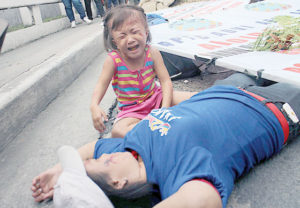WORKERS and students rushed out of buildings when sirens blared at 9 a.m. on Wednesday, signaling the start of the annual quake drill organized by the Metropolitan Manila Development Authority (MMDA).
Businesses in Metro Manila (National Capital Region or NCR) temporarily stopped as rescue teams started to “respond” to “emergencies” triggered by a 7.2-magnitude earthquake.
In Makati City, the Guadalupe Bridge “collapsed,” separating the cities of Makati, Pasay, Taguig, Las Piñas, Muntinlupa and Parañaque and the town of Pateros from the rest of the NCR.
Emergency and rescue personnel sprang into action, helping “casualties,” dousing “fires” and stopping “looting.”
Several “rescue” operations were conducted at the high-rise Makati City Hall building, using the local government’s heavy response rescue equipment, to fetch “stranded people.”
In Guadalupe, “bodies” were fished out of the Pasig River, while a collapsed structure rescue was executed at the Metro Rail Transit 3.
Firemen struggled to put out a “fire” at the Metropolitan Manila Development Authority building, while ambulances ferried the “injured” to hospitals.
A newly-acquired radar command tent was installed on Angono Street to serve as the command post of the incident management team.
The tent is equipped with solar lighting, a rubber boat with paddles and propellers, two bicycles, cooking equipment, sleeping quarters, five LED TVs and one box TV for monitoring CCTV feeds.
At the Senate, the Sergeant-At-Arms had to be “rescued” after being trapped in his office after the third floor of the building “collapsed.”
Teams of firefighters and rescue personnel rushed to “save” the employees on the fourth and fifth floors while other personnel were “evacuated” by ambulances and buses.
“We are holding this practice so employees will know what to do and where to go in case of an earthquake,” Senate Secretary Oscar Yabes said.
Yabes gave a lecture on the dos and don’ts during an earthquake, instructing employees to stay away from glass windows and to look for shelter under tables in case of falling debris.
The Manila International Airport Authority (MIAA) also held its own earthquake on drill.
MIAA senior assistant general manager Vicente Guerzon said exercises were conducted at the International Cargo Terminal (ICT) where cargo concessionaires particularly Philippine Airlines (PAL) Cargo, FedEx and the Philippine Skylanders Inc. (PSI) Cargo hold office.
“Assessing the extent of human intervention that can be done to minimize risks is crucial
to preparing for the ‘Big One’ aside from simply looking at the possible consequences of an earthquake,” the MIAA said.
It added that the entire month of June was dedicated to reorienting stakeholders and emergency response teams on the protocols under the Airport Emergency Plan.
The authority also gave assurances that terminals of the premier Ninoy Aquino International Airport can withstand a 7.6 magnitude earthquake.
WITH JEFFERSON ANTIPORDA AND BENJIE L. VERGARA


